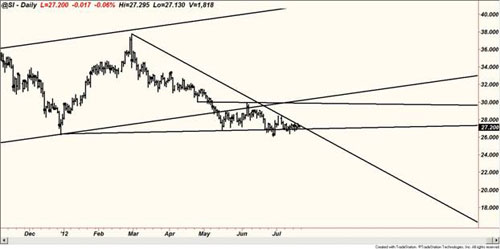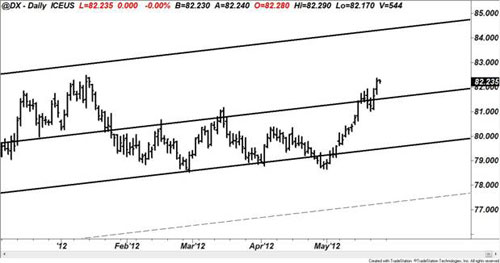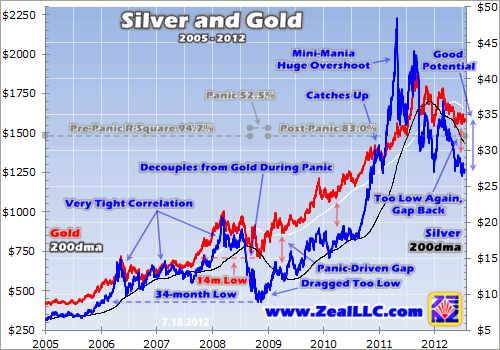Stocks & Equities
This week could be a huge one for stocks and commodities. This morning the dollar index is taking another run at our weekly chart resistance level. If it can break out and start to rally this week then a possible 4-6 week sell off in stocks and commodities may be just starting.
Watch the morning video or at least the last 4 minutes where I cover the SP500 intraday and daily chart which shows the main cycles and what we should be expecting within the coming days and weeks.

re- Market Analysis Points:
– Dollar index is making new highs this morning and if it can hold up into the close today then I would expect it to keep running higher for a few weeks.
– Oils has pulled back 5% from its high last Thursday and is now testing support and starting to bounce.
– Natural gas is holding up well after Friday’s strong rally to new highs. It may be forming a bearish pattern with the three sharp surges to new highs pattern which I explain in the video.
– Gold and silver trader trading down 1+% and are likely to find a little support today as they test support levels. They are at risk of a major breakdown but currently they are still holding up.
– Bonds are reaching new highs this morning but looking ready for a 1-3 day pause. They are a little overbought.
– SP500 charts have been the most interesting the past couple months which is why I keep focusing on it.
If you did not read my special report and wave counts then do so here: http://www.thegoldandoilguy.com/articles/put-your-seatbelts-on-its-about-to-get-bumpy/
Watch Video Now: http://www.thetechnicaltraders.com/ETF-trading-videos/
The video clearly explains where the market seems to be trading in terms of cycles and what we should expect this week and in the coming month.
Chris Vermeulen
Tags: Market Cycle, market forecast, Stock Market Cycles, Stock Market Predictions
This entry was posted on Monday, July 23rd, 2012 at 8:56 am and is filed under Daily Market Trades, Market Forecast, Stock Market Predictions, Traders Buzz, Trading Videos. You can follow any responses to this entry through the RSS 2.0 feed. Both comments and pings are currently closed.
Dog days of summer? Not much happening in the markets? Tight trading ranges? Yes, all are true. But that’s no reason to be complacent! Quiet markets and tight trading ranges can be very deceiving, often leading to surprises. (
(Ed Note: If you’d prefer to watch this presentation in Video go HERE)
The last couple of weeks since I last spoke with you by video haven’t seen much in the markets other than tight trading ranges, a lot of coiling up like a spring ready to break.
That’s somewhat understandable considering we’re almost in the dog days of summer. And there’s a lot of uncertainty about what’s happening in Europe and, of course, the latest developments in the Middle East with Iran and Syria.
The major trends have not changed so let’s go right to the charts.
Gold: Here is a fresh new chart of gold. As you can see, gold is largely going quite a bit sideways. It’s coiling up and that’s usually an indication of a substantial move coming.
I do believe that it will be to the downside. Nothing’s changed there.
My system signals continue to suggest a sharp move to the downside; however, in a tight trading like this anything goes. I wouldn’t be surprised to see one last rally out of gold, even up to $1,680, before the next leg down occurs. You can see right here there’s tremendous resistance overhead in gold between $1,680 and $1,700.
Bear in mind, I’m long-term very bullish on gold, but that next leg up in gold will not materialize until we get a solid test of long-term support down below $1,500, probably around the $1,400 level.

Silver: Silver, much like gold as you can see here, is really coiling up in a very tightly wound trading action here. Silver, like gold, could stage one last rally. However, I believe that we are still very likely to see $23 and $20 silver before silver’s long-term bull market reemerges.
You can see here it’s on the edge of doing something in this contracting triangle — we’re very close to perhaps a short-covering rally or a complete breakdown.
There isn’t much in the way of support once $26 is broken. There’s some minor technical support at $23, and then really no support until around the $20 level. So keep your eyes on both gold and silver. I think we’re close to some significant moves there despite the recent, very tight, sideways action.

U.S. Dollar Index: The dollar is looking very healthy here, again, because the euro is so sickly. The dollar has had a nice uptrend, which I correctly forecast.
We’ve pulled back a little bit and we could pull back a little bit further basis the Dollar Index to about 83, but then we should see another leg higher to the 86, 87 level as Europe’s crisis continues to roll on.

Dow Industrials: The Dow Industrials have been very resilient, which is a testament to what I’ve been telling you all along — that it is in a new long-term bull market; but short- and intermediate-term, the Dow is not acting that well.
The internals on the Dow Industrials are not very strong. The breath of the recent rally is not very healthy. Volume is lackluster. As you can see from this pattern here it’s really not, as Elliott Wave people would call it, impulsive to the upside.
This is a correction. And we are now at a very significant resistance level in the Dow. So I would not be surprised to see the Dow start to roll over.
I’m still looking for a test just below 12,000, 11,500, maybe even 11,000 down here, before the next big leg up in the Dow Industrials occurs.

As quiet as the markets have been in choppy, tight trading ranges over the last couple weeks, and the fact that we’re heading into the dog days of summer, I do recommend that you stay in touch with all my writings and keep abreast of the markets because, as you can see from these charts, things are coiling up and that’s usually a sign, a precursor, of some big moves ahead.
So stay tuned and have a good week.
The Age of Deflation is Intensifying:
Last week I wrote about how interest rates on some European government debt was trading at a negative yield…that is…you buy short term German or Swiss bonds and you get your money back…minus a safekeeping charge. This week the number of European countries with government securities trading at negative yields grew to include Germany, Switzerland, Holland, Finland, Denmark and Austria….while the yield on Spanish 10 year government bonds rose to 7.3%…their highest level since the introduction of the Euro.
This week the value of the Euro fell to a 2 year low against the US Dollar, a 12 year low against the Yen, a 21 year low against the CAD and a 23 year low against the AUD.
Credit Quality Spreads Widen:
The market is focused on Spain…where the debt problems only seem to be getting worse…while at the same time citizens of countries that might provide financial help, particularly Germany, seem to be increasingly unwilling to do so….this is making the “Euro debt crisis” an even tougher problem to solve…fear is driving capital from the periphery to the center in an attempt to find relative safety…the yield spreads between problem countries and perceived safe havens continues to widen.
The Crisis Could Get Much Worse – Quickly:
Despite the fact that several European financial crisis have come and gone over the past couple of years it now feels as though the crisis could suddenly take a dramatic turn for the worse…the debt problems seem to be getting much bigger and the solutions seem to be getting much harder to find. A dramatic turn for the worse would have a contagion effect on global markets…which would inspire central bankers to take dramatic action…have no doubt, when push comes to shove central bankers will fight deflation with stimulus.
A Real Crisis Could Produce a Real Solution:
Perhaps a really dramatic crisis will force the politically unpalatable action necessary for a lasting solution to the European debt crisis…such a solution would certainly include default/bankruptcy in some form…either a debt write-off or a dilution of liabilities through the adoption a new currency.
If The Stock Markets Aren’t Much Worried – The Credit Markets Certainly Are:
Until Friday the major European and North American stock markets had made good gains for the week…they appeared oblivious to the European credit market stresses, and to the growing evidence of a global economic slow down. Perhaps the markets sensed more central bank stimulus was coming soon, although Fed Chairman Bernanke seemed to rule that out during his Congressional presentations…or perhaps the stock markets were benefiting from capital flows seeking safety….however they turned sharply lower Friday as the Spanish debt crisis intensified.
Despite the European stresses and the evidence of a global economic slowdown the DJI has rallied nearly 1,000 pts from its June 4 lows to this week’s highs…the British, German and French stock markets have also made good gains while the AUD has rallied over 8 cents, and the CAD is up 3.5 cents. However, if the stock markets aren’t worried the credit markets certainly are…witness the negative yields in perceived European safe haven countries and note that the yields on all US Government debt are at or near all time record lows…even while the US Treasury issues new debt at a record pace.
Two Big Risks Ahead For Investors As The Macro-Economic Deflation Intensifies:
1) Asset prices decline, and
2) Taxes on “rich” people will go up. This will make it harder to preserve capital…and it won’t much matter which political party is in charge…the “math” of the debt problems supersedes political dogma…way more money has been borrowed than will ever be repaid…and somebody…maybe everybody…is going to get stuck with the “bill.” As veteran analyst Richard Russell says of a bear market, “He who loses the least wins.” My long term savings remain very conservative and liquid and I’ve also been very cautious lately with my short term trading accounts.

All over Europe right now Banks are going Bankrupt, Governments are flat broke or worse, and currencies are all over the place. Now the US Federal Reserve thinks some US Money Market Funds are so wobbly they are considering limiting the amount of money an investor can withdraw from them.
European institutions are so stricken that currently investors are actually paying a financially secure Germany to take their money. These financial storms in Europe and the US are creating waves that could smash against Canadian shores at any moment, so now might be a good time for an investor to examine their exposure to Money Market Funds. A startling line from a Fed Official in the artice below: “The delay would ensure that redeeming investors remain partially invested in the fund long enough to share in any imminent portfolio losses or costs arising from their redemptions,”
Fed Eyes Limiting Money-Market Fund Withdrawals
NEW YORK–The Federal Reserve Bank of New York said it supports limiting some types of money-market fund withdrawals in a bid to protect those funds from suffering the equivalent of a bank run.
The recommendations came from a staff report released Thursday. New York Fed President William Dudley in a press release accompanying the document said he “strongly” endorses the ideas put forth by authors Patrick McCabe, Marco Cipriani, Michael Holscher and Antoine Martin.
“Further reform of money funds is essential for our nation’s financial stability,” Mr. Dudley said.
The analysts propose that money-market funds could be strengthened if they were to have a “minimum balance at risk.” As envisaged by the authors, this balance “would be a small fraction of each shareholder’s recent balances that would be set aside in the event that they withdrew from the fund,” the press release said.
While regular transactions would be allowed as they are now, this special minimum balance would be locked up for 30 days. “The delay would ensure that redeeming investors remain partially invested in the fund long enough to share in any imminent portfolio losses or costs arising from their redemptions,” the bank explained.
The idea advanced in the New York Fed paper seeks to force investors to be more mindful of what they are doing with money-market fund investments. Many perceive the funds to be a very safe and liquid place to park funds. But that notion was tested during the 2008 financial crisis, and some have worried that in the current environment, money-market funds could be a prime conduit for importing Europe’s ongoing financial crisis to the U.S.
Money-market funds currently hold some $2.7 trillion in assets, according to the paper. They own, as of late 2011, around 40% of all dollar-denominated commercial paper, the New York Fed said.
The report provides fodder for Securities and Exchange Commission Chairman Mary Schapiro as she inches her divided agency toward a vote as early as this summer on a proposal to strengthen money-fund regulations. SEC officials described the New York Fed paper as a “blueprint” for the changes Ms. Schapiro would like to make.
Ms. Schapiro, joined by Federal Reserve and Treasury Department officials, sees money funds as one of the weakest links in the financial system despite reforms adopted two years ago to make the industry more resilient to widespread redemptions. Fund firms and other experts say the cash-like investments rarely run into serious trouble.
To publicly float her proposals, Ms. Schapiro needs “yes” votes from two of her four fellow commissioners. For months, three of the commissioners have said they don’t believe there is sufficient evidence additional money-fund overhauls are needed, effectively blocking the proposals’ advancement.
A number of Fed officials have been anxious about money-market funds for some time. Central bankers see the funds as a prime source of risk in large part because their structure is such that when trouble, or the fear of trouble, arises, investors have every incentive to withdraw all their funds. That can create the equivalent of a bank run.
In congressional testimony Wednesday, Fed Chairman Ben Bernanke said money-market funds are currently a potential source of financial-market instability. He expressed his support of regulators’ attempts to lower the source of risk posed by money funds.
Bottom Line, Canadians Banks are well capitalized, tightly regulated and some of the safest in the world. That said, there is no rule that say’s they can’t reinvest your cash in Banks/Corporations/Government short term paper so they can pay you a small investment return. Suddenly Money Market Funds are riskier when you consider what just happened in, Spain (small savers in Banks are losing billions of Euros), or MF Global which filed for Bankruptcy after investing in European sovereign debt. to counter this risk, this Federal Reserve will simply prevent you from taking all of your cash from a Money Market Fund in one transaction. Oops. A Global “Bank Run” would make it extremely difficult for Money Market Funds to liquidate the short term securities it invests in so that they can pay you back promptly.
In short, no longer assume that you can always get your cash from a Money Market Fund when you want it. Moreover there is the possibility that the “cash” you have in a Money Market Fund could vaporize as it has for so many Spaniards and investors in the Broker/Dealer MF Global.
Things are getting very tough worldwide. Be sure to take the time to check on any cash you have in Money Market Funds.
















